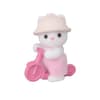IMG_0234.jpeg
Document Details

Uploaded by InsightfulChrysoprase2384
Full Transcript
## 1.3 How Do We Measure Physical Quantities? ### Avoiding Errors of Measurement * When using a metre rule, our eyes should be positioned such that our line of sight is **perpendicular** to (directly above) the rule. * This is to avoid **parallax errors**. * Figure (a): Accurate measurem...
## 1.3 How Do We Measure Physical Quantities? ### Avoiding Errors of Measurement * When using a metre rule, our eyes should be positioned such that our line of sight is **perpendicular** to (directly above) the rule. * This is to avoid **parallax errors**. * Figure (a): Accurate measurement. The accurate length of an object is = 2.9 - 1.9 cm * Figure (b): Inaccurate measurement. The inaccurate length of an object is = 3.0 - 0.9 = 2.1 cm * Avoid using the zero mark of the metre rule as a start point to take measurements. This is because wear and tear may make it unsuitable for measuring purposes. The worn end may introduce errors to the readings. ### Random Errors * Random errors are unpredictable and cluster around a mean value, which can be minimized by taking several readings and calculating the average. ### Systematic Errors * Systematic errors are constant and predictable. These can be avoided by calibrating the equipment, which if not corrected, can lead to measurements far from the true value. ## 1. 3 How Do We Measure Physical Quantities? ### Digital callipers * They are used to measure the internal and external diameters of an object accurately. * The tail of the callipers are used to measure the depth of an object. * **Diagram:** The diagram shows a digital calliper. * It shows the outside jaws used to measure the external diameter or width of an object. * It shows the inside jaws, used to measure the internal diameter of an object. * It shows the scale on the callipers. * Lastly, it shows the tail, used to measure the depth of an object. * Additional features in the diagram: the locking screw - used to ensure that the jaws do not move apart, the digital display - used to show the numeric value and the zero button - used to reset displayed length back to zero. ## 1. 3 How Do We Measure Physical Quantities? ### Micrometer Digital callipers Screw Gauge * Used to measure objects that are too small to be measured using the digital callipers. * **Diagram:** The diagram shows a micrometer. * Its parts are labelled: Anvil, spindle, scale, and the digital display - used to show numeric value. * Additional features in the diagram: the ratchet - can be turned to adjust the spindle so that the spindle is in contact with the object, the thimble, the zero button - used to reset displayed length back to zero.